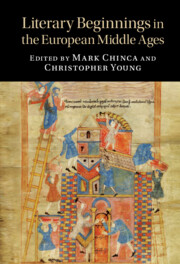Book contents
- Literary Beginnings in the European Middle Ages
- Cambridge Studies in Medieval Literature
- Literary Beginnings in the European Middle Ages
- Copyright page
- Contents
- Contributors
- Acknowledgments
- Foreword
- Chapter 1 Introduction
- Chapter 2 Scandinavia
- Chapter 3 Irish and Welsh
- Chapter 4 English
- Chapter 5 Spain
- Chapter 6 French
- Chapter 7 Dutch
- Chapter 8 Occitan
- Chapter 9 German
- Chapter 10 Italian
- Chapter 11 Czech and Croatian
- Chapter 12 Greek
- Chapter 13 East Slavonic
- Afterword
- Index
- Cambridge Studies in Medieval Literature
Chapter 1 - Introduction
Published online by Cambridge University Press: 11 August 2022
- Literary Beginnings in the European Middle Ages
- Cambridge Studies in Medieval Literature
- Literary Beginnings in the European Middle Ages
- Copyright page
- Contents
- Contributors
- Acknowledgments
- Foreword
- Chapter 1 Introduction
- Chapter 2 Scandinavia
- Chapter 3 Irish and Welsh
- Chapter 4 English
- Chapter 5 Spain
- Chapter 6 French
- Chapter 7 Dutch
- Chapter 8 Occitan
- Chapter 9 German
- Chapter 10 Italian
- Chapter 11 Czech and Croatian
- Chapter 12 Greek
- Chapter 13 East Slavonic
- Afterword
- Index
- Cambridge Studies in Medieval Literature
Summary
The introduction pursues three aims: it examines the problems of representing beginnings in literary history in general; it explains the value of a literary history that focuses on the beginnings, rather than the subsequent development, of vernacular literatures in medieval Europe; and it describes the advantages of a comparative approach. In respect of the first aim, it argues that we should neither posit a unitary beginning for literature in any language nor think in terms of causes and effects: every literary tradition passes through multiple moments of incipience and opening, and their study reveals conditions of possibility, not mechanistic causes. Second, a concentration on beginning obliges us to define what begins, thereby bringing to light the distinctive features of each vernacular literature. Third, the comparative perspective reveals the matrix of defining characteristics that the nascent European literatures of the Middle Ages all share: their manuscript materiality, their institutionalization in systems of textual practice which confer stability and persistence in space and time, and, finally, their linguistic vernacularity, which defines them over against their respective ‘parental’ literacies in Latin, Greek, or Church Slavonic.
Keywords
- Type
- Chapter
- Information
- Literary Beginnings in the European Middle Ages , pp. 12 - 22Publisher: Cambridge University PressPrint publication year: 2022



